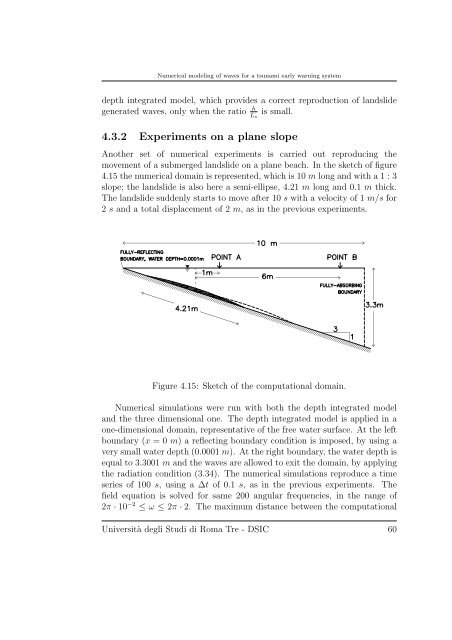Numerical modeling of waves for a tsunami early warning system
Numerical modeling of waves for a tsunami early warning system
Numerical modeling of waves for a tsunami early warning system
You also want an ePaper? Increase the reach of your titles
YUMPU automatically turns print PDFs into web optimized ePapers that Google loves.
<strong>Numerical</strong> <strong>modeling</strong> <strong>of</strong> <strong>waves</strong> <strong>for</strong> a <strong>tsunami</strong> <strong>early</strong> <strong>warning</strong> <strong>system</strong><br />
depth integrated model, which provides a correct reproduction <strong>of</strong> landslide<br />
generated <strong>waves</strong>, only when the ratio h is small.<br />
Ls<br />
4.3.2 Experiments on a plane slope<br />
Another set <strong>of</strong> numerical experiments is carried out reproducing the<br />
movement <strong>of</strong> a submerged landslide on a plane beach. In the sketch <strong>of</strong> figure<br />
4.15 the numerical domain is represented, which is 10 m long and with a 1 : 3<br />
slope; the landslide is also here a semi-ellipse, 4.21 m long and 0.1 m thick.<br />
The landslide suddenly starts to move after 10 s with a velocity <strong>of</strong> 1 m/s <strong>for</strong><br />
2 s and a total displacement <strong>of</strong> 2 m, as in the previous experiments.<br />
Figure 4.15: Sketch <strong>of</strong> the computational domain.<br />
<strong>Numerical</strong> simulations were run with both the depth integrated model<br />
and the three dimensional one. The depth integrated model is applied in a<br />
one-dimensional domain, representative <strong>of</strong> the free water surface. At the left<br />
boundary (x =0m) a reflecting boundary condition is imposed, by using a<br />
very small water depth (0.0001 m). At the right boundary, the water depth is<br />
equal to 3.3001 m and the <strong>waves</strong> are allowed to exit the domain, by applying<br />
the radiation condition (3.34). The numerical simulations reproduce a time<br />
series <strong>of</strong> 100 s, usingaΔt <strong>of</strong> 0.1 s, as in the previous experiments. The<br />
field equation is solved <strong>for</strong> same 200 angular frequencies, in the range <strong>of</strong><br />
2π · 10 −2 ≤ ω ≤ 2π · 2. The maximum distance between the computational<br />
Università degli Studi di Roma Tre - DSIC 60

















